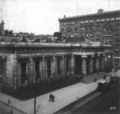
The Eastern State Penitentiary (ESP) is a former American prison in Philadelphia, Pennsylvania. It is located in the Fairmount section of the city, and was operational from 1829 until 1971. The penitentiary refined the revolutionary system of separate incarceration, first pioneered at the Walnut Street Jail, which emphasized principles of reform rather than punishment.

Egyptian Revival is an architectural style that uses the motifs and imagery of ancient Egypt. It is attributed generally to the public awareness of ancient Egyptian monuments generated by Napoleon's conquest of Egypt and Admiral Nelson's defeat of the French Navy at the Battle of the Nile in 1798. Napoleon took a scientific expedition with him to Egypt. Publication of the expedition's work, the Description de l'Égypte, began in 1809 and was published as a series through 1826. The size and monumentality of the façades discovered during his adventure cemented the hold of Egyptian aesthetics on the Parisian elite. However, works of art and architecture in the Egyptian style had been made or built occasionally on the European continent since the time of the Renaissance.

Thomas Ustick Walter was the dean of American architecture between the 1820 death of Benjamin Latrobe and the emergence of H. H. Richardson in the 1870s. He was the fourth Architect of the Capitol and responsible for adding the north (Senate) and south (House) wings and the central dome that is predominantly the current appearance of the U.S. Capitol building. Walter was one of the founders and second president of the American Institute of Architects. In 1839, he was elected as a member to the American Philosophical Society.

The Philadelphia History Museum was a public history museum located in Center City, Philadelphia from 1938 until 2018. From 1938 until 2010, the museum was known as the Atwater Kent Museum. The museum occupied architect John Haviland's landmark Greek Revival structure built in 1824–1826 for the Franklin Institute. The Museum operated as a city agency as part of Philadelphia's Department of Recreation. The building was listed on the National Register of Historic Places on August 1, 1979.

James Elmes was an English architect, civil engineer, and writer on the arts.

Napoleon Eugene Charles Henry LeBrun was an American architect. He began his career in Philadelphia designing churches and theatres including St. Augustine's Church, the Cathedral-Basilica of Sts. Peter and Paul and the Philadelphia Academy of Music. He moved to New York City, established the firm Napoleon LeBrun & Sons and designed multiple additional churches. He became the official architect of the Fire Department of New York and designed 42 firehouses between 1879 and 1895. He also designed early skyscrapers in New York City such as the Metropolitan Life Insurance Company Tower and the Home Life Building.
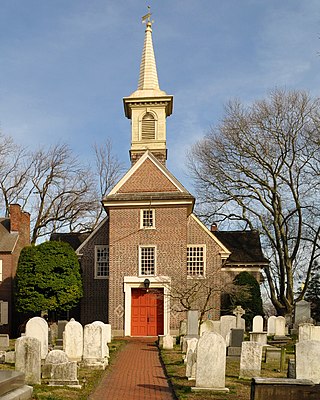
The architecture of Philadelphia is a mix of historic and modern styles that reflect the city's history. The first European settlements appeared within the present day borders of Philadelphia, Pennsylvania in the 17th century with most structures being built from logs. By the 18th century, brick structures had become common. Georgian and later Federal style buildings dominated much of the cityscape. In the first half of the 19th century, Greek revival appeared and flourished with architects such as William Strickland, John Haviland, and Thomas U. Walter. In the second half of the 19th century, Victorian architecture became popular with the city's most notable Victorian architect being Frank Furness.

Horace Trumbauer was a prominent American architect of the Gilded Age, known for designing residential manors for the wealthy. Later in his career he also designed hotels, office buildings, and much of the campus of Duke University.

Samuel Sloan was a Philadelphia-based architect and best-selling author of architecture books in the mid-19th century. He specialized in Italianate villas and country houses, churches, and institutional buildings. His most famous building—the octagonal mansion "Longwood" in Natchez, Mississippi—is unfinished; construction was abandoned during the American Civil War.
John von Sonntag de Havilland was an officer of arms at the College of Arms in London during the 19th century. He is notable for being one of only two English officers of arms to have been born in the United States of America.

Theophilus Parsons Chandler Jr. was an American architect of the late 19th and early 20th centuries. He spent his career at Philadelphia, and is best remembered for his churches and country houses. He founded the Department of Architecture at the University of Pennsylvania (1890), and served as its first head.

Russell Warren (1783–1860) was an American architect, best known for his work in the Greek Revival style. He practiced in Bristol and Providence.
John Lee Archer was the Civil Engineer and Colonial Architect in Van Diemen's Land, serving from 1827 to 1838. During his tenure, Archer was responsible for all Tasmanian government buildings including those for penal and military purposes.
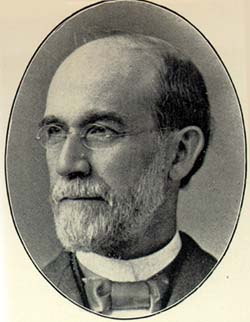
Addison Hutton (1834–1916) was a Philadelphia architect who designed prominent residences in Philadelphia and its suburbs, plus courthouses, hospitals, and libraries, including the Ridgway Library, now Philadelphia High School for the Creative and Performing Arts, and the Historical Society of Pennsylvania. He made major additions to the campuses of Westtown School, George School, Swarthmore College, Bryn Mawr College, Haverford College, and Lehigh University.

John McArthur Jr. (1823–1890) was a prominent American architect based in Philadelphia. Best remembered as the architect of the landmark Philadelphia City Hall, McArthur also designed some of the city's most ambitious buildings of the Civil War era. Few of his buildings survive.

Wilson Brothers & Company was a prominent Victorian-era architecture and engineering firm based in Philadelphia, Pennsylvania. The company was regarded for its structural expertise.

William L. Johnston (1811–1849) was a carpenter-architect who taught architectural drawing at the Carpenters' Company of Philadelphia, and won a number of important Philadelphia commissions. He died of tuberculosis at the age of 38 after a trip abroad for his health.
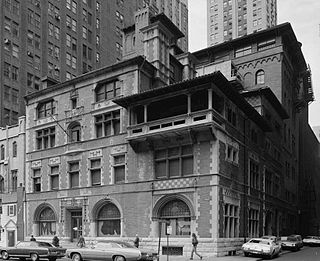
Frank Miles Day was a Philadelphia-based architect who specialized in residences and academic buildings.
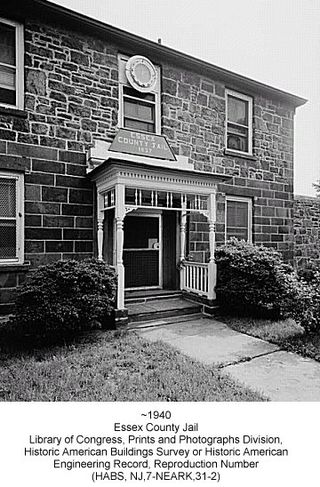
The old Essex County Jail is located in the University Heights section of Newark, Essex County, New Jersey, United States. The jail is Essex County's oldest public building and a national landmark of value for its architectural and social history. The complex consists of about 20 structures of various size, age, and function ranging in date from the 1830s to 1930s. Collectively, they represent the evolution of American prison history over 100 years. For the quality of its architecture, its social history, and its links to the 1967 Newark Riots, this jail was added to the National Register of Historic Places on September 3, 1991. The site has been abandoned since 1971 and remains property of the City of Newark.
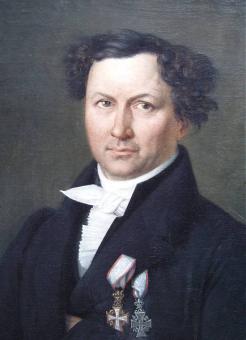
Jørgen Hansen Koch was a Neoclassical Danish architect. He was chief of the national Danish building administration from 1835 and director of the Royal Danish Academy of Fine Arts from 1844 to 1849.









